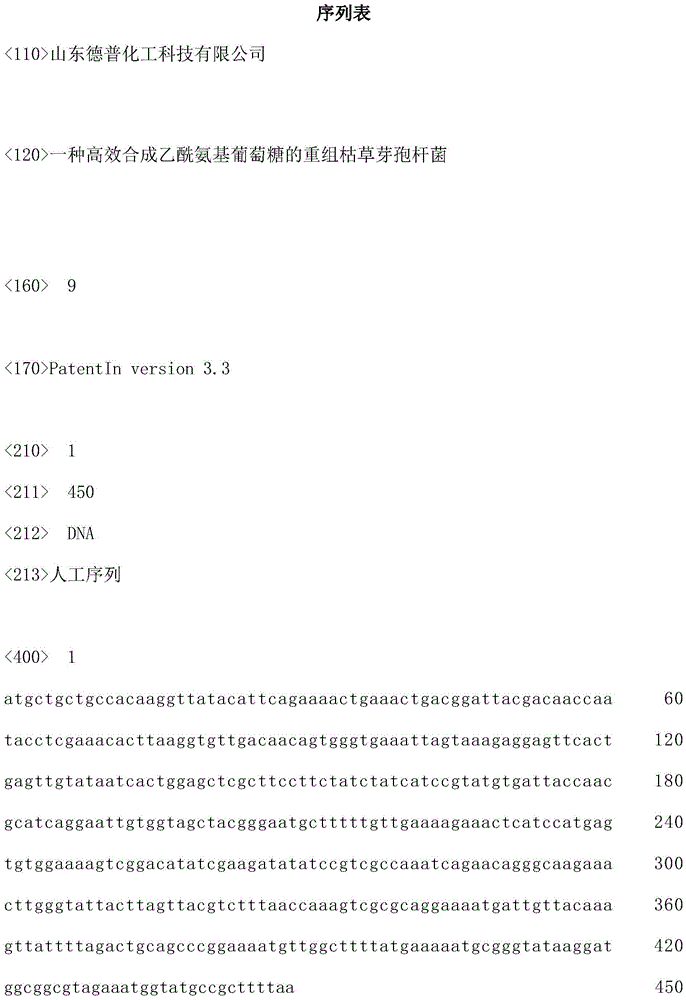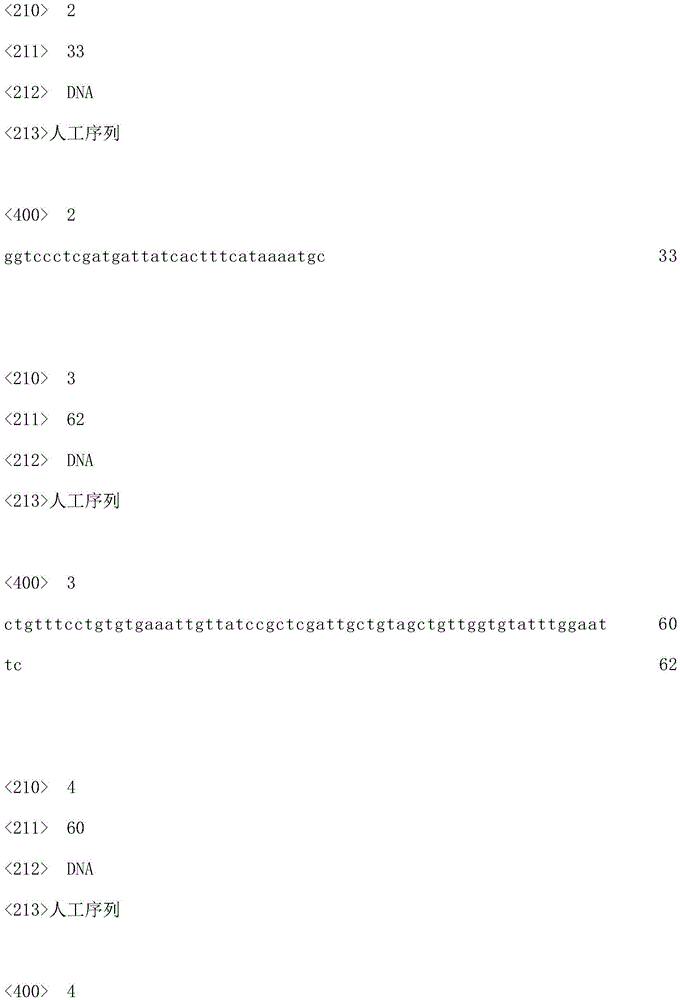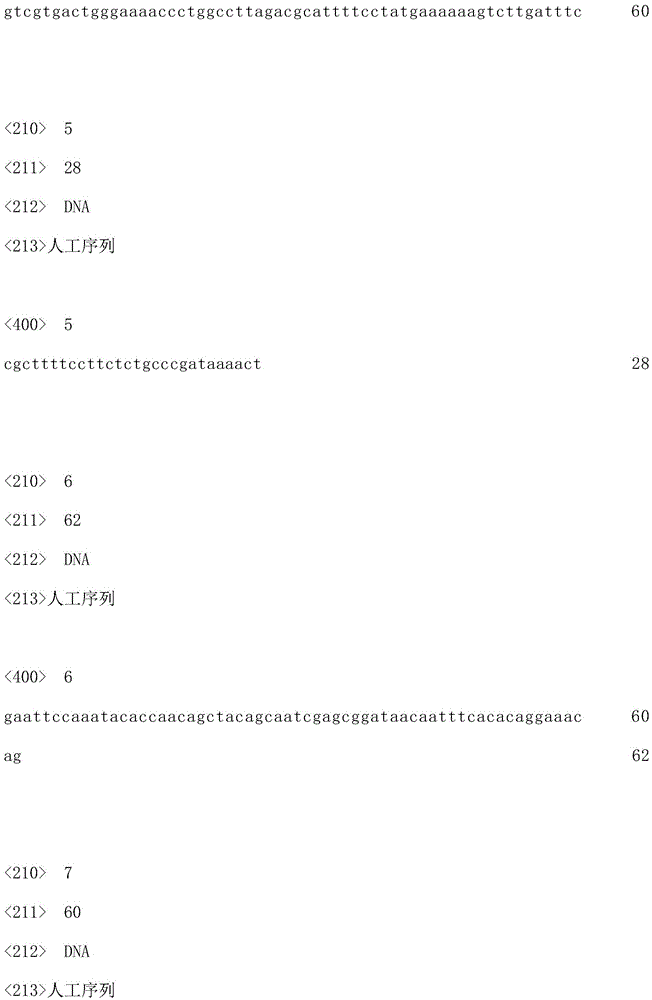Recombinant Bacillus subtilis for efficiently synthesizing acetylglucosamine
A technology of Bacillus subtilis and glucosamine, applied in the field of genetic engineering, can solve problems such as the increase of acetyl glucosamine and the inability to obtain the accumulation concentration of acetyl glucosamine
- Summary
- Abstract
- Description
- Claims
- Application Information
AI Technical Summary
Problems solved by technology
Method used
Image
Examples
Embodiment 1
[0042] Example 1: Knocking out the non-essential region skin on the genome
[0043] According to the genome sequence of Bacillus subtilis (Bacillus subtilis 168, purchased from the American Type Microorganism Collection, ATCC No.27370) published on NCBI, primers for amplification of the homology arms of the knockout frame were designed, and the primers for the upper and lower arms of the left arm were: skin- L-F (sequence shown in SEQ ID NO.2) and skin-L-R (sequence shown in SEQ ID NO.3); right arm upstream and downstream primers are: skin-R-F (sequence shown in SEQ ID NO.4) and skin-R-R (sequence shown in SEQ ID NO.5).
[0044] The left and right arms contained in the knockout frame were amplified from the Bacillus subtilis 168 genome using the above primers. According to the p7Z6 plasmid sequence published on NCBI (NCBI accession no.EU541492), design primers to amplify the bleomycin resistance gene (zeo), the upstream and downstream primers are: skin-Z-F (sequence such as S...
Embodiment 2
[0053] Embodiment 2: Construction of recombinant plasmid
[0054] According to the nucleotide sequence of the glucosamine acetylase encoding gene (CaGNA 1) in Candida albicans (Candida albicans SC5314) published on NCBI as shown in NCBIGenBank: XM_715990.1, the codon preference optimization of Bacillus subtilis was carried out, and the nucleoside The acid sequence is as SEQ ID NO.1, and the gene sequence was synthesized by Shanghai Sangon Bioengineering Co., Ltd. Design primers CaGNA1-F (sequence shown in SEQ ID NO.8): 5'-GGGGTACCATTATAGGTAAGAGAGGAATGTACACATGCTGCTGCCACAAGGTTATACAT-3', CaGNA1-R (sequence shown in SEQ ID NO.9): 5'-CCCAAGCTTTTAAAAGCGGCATACCATTTCTACG-3'. The glucosamine acetylase encoding gene (CaGNA1) was amplified from the synthetic sequence nucleotide sequence SEQID NO.1 using the above primers. The amplified fragment was digested with KpnI and HindIII and ligated into pP43NMK expression vector. Restriction digestion and sequencing confirmed the successful co...
Embodiment 3
[0055] Embodiment 3: the construction of recombinant Bacillus subtilis
[0056] Transform the constructed expression vector pP43-CaGNA1 into recombinant Bacillus subtilis BSGN6-Δskin-P xylA -glmS and BSGN6-P xylA -glmS. Using CaGNA1-F and CaGNA1-R primers to select transformants for colony PCR, a 450bp band appeared, verifying that the recombinant Bacillus subtilis was successfully constructed, and the recombinant Bacillus subtilis BSGN6Δskin-P was obtained respectively xylA -glmS -P 43 -CaGNA1 and BSGN6-P xylA -glmS -P 43 -CaGNA1.
PUM
 Login to View More
Login to View More Abstract
Description
Claims
Application Information
 Login to View More
Login to View More - R&D
- Intellectual Property
- Life Sciences
- Materials
- Tech Scout
- Unparalleled Data Quality
- Higher Quality Content
- 60% Fewer Hallucinations
Browse by: Latest US Patents, China's latest patents, Technical Efficacy Thesaurus, Application Domain, Technology Topic, Popular Technical Reports.
© 2025 PatSnap. All rights reserved.Legal|Privacy policy|Modern Slavery Act Transparency Statement|Sitemap|About US| Contact US: help@patsnap.com



